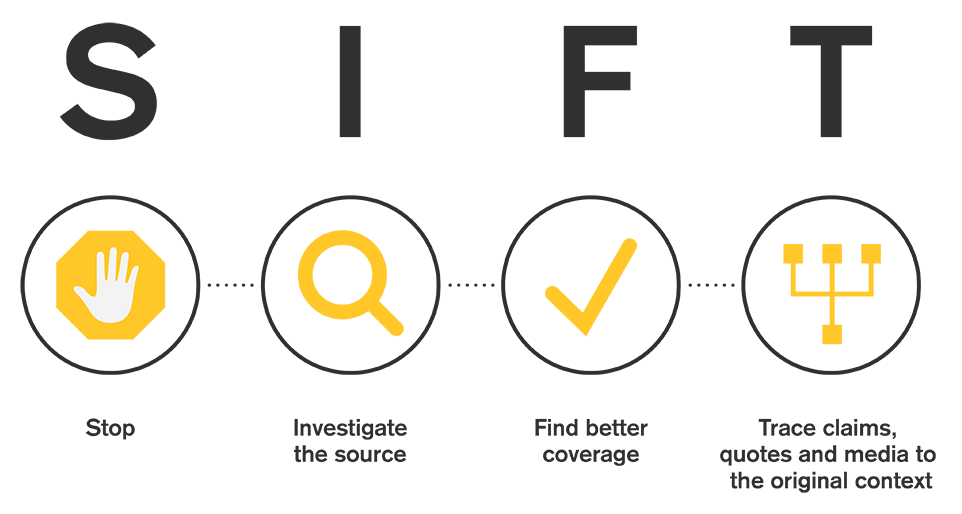6 Mediactive principles for media consumers
How do you choose what news story to read or Instagram post to share? Most of us consume and share media that grabs our attention without vetting it much. But a better approach is to shift your mindset about how you choose what media to read, listen to and watch. These six simple principles can help stop the misinformation cycle before it begins.
1. Be skeptical.
We can never take for granted that the media we consume is without fault. Even trustworthy media organizations make mistakes, and social media isn’t exactly known for its credibility. So we have to start with skepticism — about everything. This caution applies to every scrap of news and information that comes our way, including from online, print and TV news organizations, social media posts, emails and texts.
That being said, it’s important not to let skepticism turn into cynicism. Media is constantly evolving, which means there is always room for improvement. Each and every media consumer can contribute to that improvement.
2. Exercise judgment.
Not believing in anything can be as dangerous as being too trusting. We need to apply sound judgment. Businesses call the process of thoroughly checking out proposed deals due diligence, and it’s a term that fits here, too. Let’s bring due diligence to what we read, watch and hear. This process requires all of us to develop and use our internal “BS detectors.” Fortunately, there are smart, proven ways to sort things out:
- Don’t rely on any single source of information — even the trusted ones. Find multiples.
- Go to original sources. When looking for official information, go straight to the data source. For health information, this might be the National Institutes of Health or the Centers for Disease Control and Prevention.
- Verify claims using a method like SIFT, a technique we love from Mike Caulfield at Washington State University Vancouver:

3. Open your mind.
The so-called “echo chamber” effect — our tendency as human beings to seek information that we’re likely to agree with — is well known. To be well informed, we need to seek out and pay attention to information sources that will offer new perspectives and challenge our own assumptions, rather than simply reinforcing them. And remember, it’s also important to seek out diversity in subject matter.
The best way to accomplish this is to recognize your own biases and remove yourself from the echo chamber! Go outside your comfort zone by talking to people whose opinions differ from yours. Read books outside your chosen genre. Follow a new conversation on Twitter. A little change at a time can make a big difference — you’ll never know everything, and certainly not at once. Just open yourself up to the idea of newness.
Here are some of our favorite outlets to look to for new perspectives:
- Global Voices Online
- The Root
- Indian Country Today
- The Marshall Project
- STAT
- Word in Black
- Science News
4. Keep asking questions.
This principle goes by many names: research, reporting, homework, etc. The more important you consider a topic, the more essential it becomes to follow up on media reports about it. No single article or video tells the whole story. If you have questions, you may find answers in coverage by others. If the topic is close to home, you can ask questions directly.
Most of us already know that we need to ask questions. But do we know why? The answer goes along with skepticism. If we’re actively challenging the narratives around us and engaging our minds, we are far less prone to accepting misinformation when it’s offered — and it will always be offered.
5. Learn media techniques.
In our media-saturated society, it’s important to know how digital media works. We are all media creators to some degree, as we post on social media, share photos and videos, comment, write blog posts and so much more. Crucially, we also need to understand how media are used by various parties to inform, influence and even manipulate the rest of us.
There’s no one right way to learn media techniques, but here are a few ways to get started:
- Observe the corners of the internet you frequent, and ask yourself questions about the people involved and the content they post.
- Examine advertisements and marketing schemes. How are they using media to get you to purchase their products and ideas?
- Talk to people outside your age demographic about what media they use and why. Young people can benefit from an older perspective and vise versa.
6. Consume slow news.
When news outlets reported Kobe Bryant’s tragic death, they all rushed to be the first one out of the gate. As a result, ABC News — and many other outlets — misreported several major details. This is why being skeptical (within reason) of every outlet until you have multiple sources is necessary. So we’d like to ask you to consider a “slow news” approach, both as media consumers and creators.
What is slow news? It’s the idea that you should take a breath before believing — and especially before sharing — breaking news (and most non-breaking news). Wait for confirmation from trustworthy sources. Understand that what we think we know right now can be, and often is, either incorrect or incomplete.
These principles are just the beginning, but they can offer a whole new way of seeing the media you consume and share with others.
For more info on how to be a savvy media consumer, head over to our site Mediactive or sign up for our free three-week ASU course. You can also download a PDF of these principles for media consumers here.
Quinlyn Shaughnessy is a Mediactive teaching assistant with a love for all things media-related. She holds a BA in Mass Communication & Media Studies from ASU’s Cronkite School and can usually be found typing, reading or watching.
Twitter
